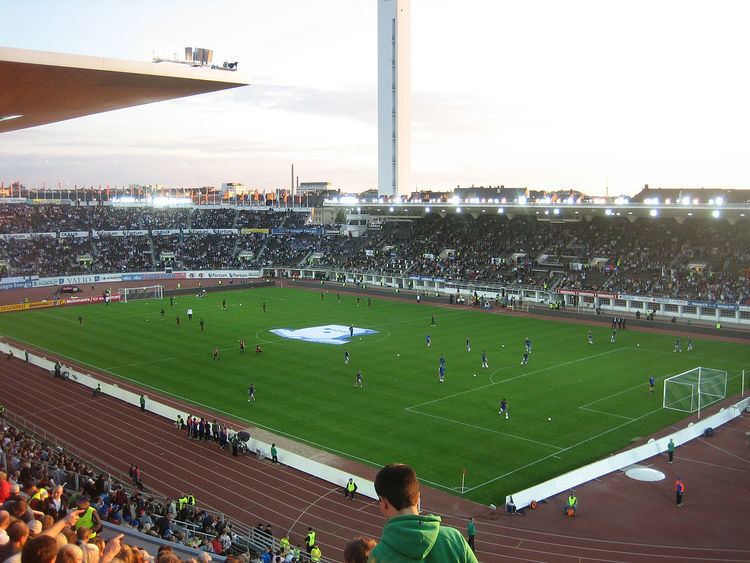Surface Grass Capacity 39,784 Phone +358 9 4366010 | Owner Stadion-säätiö Broke ground 1934 Opened 12 June 1938 | |
 | ||
Renovated 1939, 1947–1952, 1953–1956, 1961, 1971, 1991–1994, 1997–1998, 2004–2005, 2010–2011, 2016–2019 Closed 2016 for renovation works Address Paavo Nurmen tie 1, 00250 Helsinki, Finland Similar Linnanmäki, Finlandia Hall - Helsinki, National Museum of Finland, Sonera Stadium, Parliament House - Helsinki Profiles | ||
Ilmakuva helsinki olympic stadium tourist attraction
The Olympiastadion (Finnish: Helsingin Olympiastadion; Swedish: Helsingfors Olympiastadion), located in the Töölö district about 2.3 kilometres (1.4 mi) from the centre of the Finnish capital Helsinki, is the largest stadium in the country, nowadays mainly used for hosting sports events and big concerts. The stadium is best known for being the centre of activities in the 1952 Summer Olympics. During those games, it hosted athletics, equestrian show jumping, and the football finals.
Contents
- Ilmakuva helsinki olympic stadium tourist attraction
- Helsinki olympic stadium helsinki finland
- History
- Features
- Future
- Sport events
- Concerts
- References
The stadium was also the venue for the first Bandy World Championship in 1957, the first World Athletics Championships in 1983 as well as for the 2005 World Championships in Athletics. It hosted the European Athletics Championships in 1971, 1994 and 2012.
It is also the home stadium of the Finland national football team.
The Stadium has closed temporarily in March 2016 for renovation works and will reopen in 2019.
Helsinki olympic stadium helsinki finland
History
The Olympic Stadium was designed in functionalistic style by the architects Yrjö Lindegren and Toivo Jäntti. Construction of the Olympic Stadium began in 1934 and it was completed in 1938, with the intent to host the 1940 Summer Olympics, which were moved from Tokyo to Helsinki before being cancelled due to World War II. It hosted the 1952 Summer Olympics over a decade later instead. The stadium was also to be the main venue for the cancelled 1943 Workers' Summer Olympiad.
It was the venue for the first ever Bandy World Championship in 1957.
The stadium was completely modernized in 1990–1994 and also renovated just before the 2005 World Championships in Athletics.
In 2006 an American TV series, The Amazing Race 10, had one of its episodes ending at The Olympic Stadium Tower. As a task, teams had to do a face-first rappel (known as the Angel Dive) down the Helsinki Olympic Tower.
Since March 2007, a Eurasian eagle-owl has been spotted living in and around the stadium. On June 6, 2007, during a Euro 2008 qualifying match, the owl delayed play by ten minutes after perching on a goalpost. The owl was later christened Bubi and was named as Helsinki's Resident of the Year.
The 50th anniversary of the Helsinki Olympic Games hosted in the Helsinki Olympic Stadium was the main motif for one of the first Finnish euro silver commemorative coins, the 50th anniversary of the Helsinki Olympic Games commemorative coin, minted in 2002. On the reverse, a view of the Helsinki Olympic Stadium can be seen. On the right, the 500 markka commemorative coin minted in 1952 celebrating the occasion is depicted.
Features
The stadium's spectator capacity was at its maximum during the 1952 Summer Olympics with over 70,000 spectator places. Nowadays the stadium has 40,600 spectator places. During concerts, depending on the size of the stage, the capacity is 45,000–50,000.
The tower of the stadium, a distinct landmark with a height of 72.71 metres (238.5 ft), a measurement of the length of the gold-medal win by Matti Järvinen in javelin throw of 1932 Summer Olympics, is open for visitors and offers impressive views over Helsinki. It is possible to see into the adjacent Sonera Stadium.
A Youth Hostel is located within the Stadium complex.
Future
Major renovation work at the stadium started in the spring of 2016. The stadium will be closed during the construction and will reopen in 2019. During renovation all the spectator stands will be covered with canopies and the field area and the tracks will be renewed. It will also offer extended restaurant areas and more indoor sport venues.
Projected costs for the renovation is 209 million euros and it will be funded by Finnish state and the city of Helsinki.
Sport events
Concerts
Michael Jackson performed at the stadium during his HIStory World Tour two times; 24 and 26 August 1997.
U2 performed at the stadium during their PopMart Tour on 9 August 1997 and two nights during their U2 360° Tour on 20 and 21 August 2010.
Madonna performed at the stadium during her MDNA Tour on 12 August 2012.
Muse performed at the stadium during their The 2nd Law World Tour on 27 July 2013.
Bruce Springsteen has performed at the stadium four times; 16 and 17 June in 2003 during his The Rising Tour, 11 July 2008 during his Magic Tour and 31 July 2012 during his Wrecking Ball Tour.
Bon Jovi have played the stadium as part of their These Days Tour in 1996, Lost Highway Tour in 2008, and in 2011 during The Circle Tour.
Iron Maiden has performed at the stadium three times; 18 July in 2008 during Somewhere Back in Time World Tour, 8 July 2011 during The Final Frontier World Tour and 20 July 2013 during Maiden England World Tour.
One Direction performed at the stadium for the first time on 27 June 2015 during their fourth tour On the Road Again Tour.
